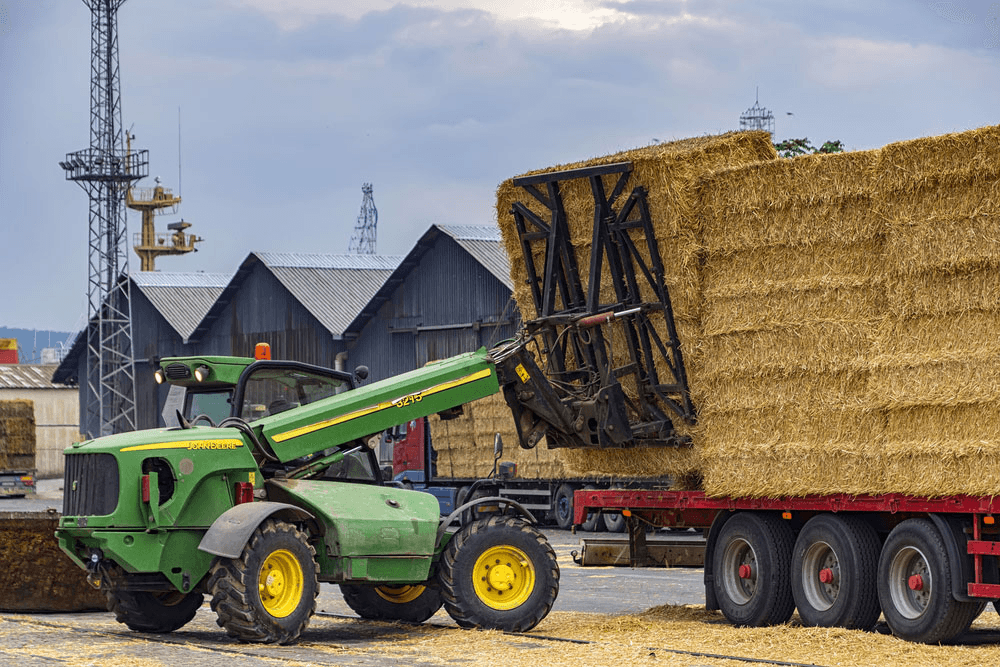Ross Grassick
Telehandlers
Why Telehandlers are Important for Growing Agricultural Businesses

Telehandlers have developed into one of the most versatile pieces of material handling equipment on the market, with a range of different attachments, capacities and lift height to choose from. And with the increase of bulk goods, bale sizes, and supply and demand materials needing to be moved in agriculture, it’s no surprise that telehandlers have become essential for businesses in the agriculture industry.
But what else is there to know about telehandlers and their role in agricultural businesses? Here we cover everything you need to know.
The role of telehandlers in agricultural applications
Modern agricultural businesses often receive supplies such as chemicals and seed that weigh more than a tonne. But the problem is that standard forklifts don’t have the ability to carry these heavy items and are generally unsuited to the farm environment, as there are unsealed work areas and large distances to be travelled.
The modern telehandler has become the solution.Designed with four-wheel drive and large wheels, they’re suitable to work in both the paddock and the back of the farm shed. Many brands such as Merlo offer agricultural versions of the telehandler, equipped with robust engines and faster road speeds which make them more versatile and quicker to get around the farm.
Technical applications of telehandlers
Like with any good forklift, superior features are essential. A quality telehandler has the right capacity, additional hydraulics, and attachments like a sturdy hay spike that will help mobilise hay grabs and make higher stacking easy in your agricultural business.
As a rule of thumb, telehandlers with lift heights of up to 9000mm are able to easily stack hay with one operator. The unit will be able to reach over a row of hay to pick up from a second row or load from one side of the truck.
There are a range of telehandler models on offer that are suitable for today’s modern feedlot, enabling bulk grain to be efficiently delivered to feed troughs. These models may also come with additional attachments that allow the driver to remove silage and waste as well.
One of the best aspects of telehandlers is that they offer so much flexibility of application with the one unit – with a quick change of attachment it can go from carrying small items to tonnes of weight in a matter of minutes. The range of attachments will cover almost any job you can think of.
This versatility makes them far more efficient, particularly as most farms today have less staff than ever, and so one person can carry out many operations without the need for assistance when using a telehandler.
While the telehandler does have a range of versatile attachments available, it should be noted that the unit and attachment must be rated to suit each other. Each unit is sold with a rating chart in the cabin unique to its capabilities and attachment recommendations.
Telehandlers are also much safer for operations in your business as they’re fitted with load cells that limit the operation to safe capacities and offer ergonomic cabin design to reduce fatigue and improve productivity.
The modern agricultural versions of some models also offer three-point linkage, as well as power take off, so they can replace some tractor operations, and with 120hp the engines do some real work.
Tips for renting or buying a telehandler
When looking to rent or purchase a telehandler you need to look at what operations it will be carrying out most of the time. While a telehandler can do many jobs, they’re generally designed to do one specialised task the best. That’s why there are so many model lift heights and capacities.
Telehandlers also come in different drive styles and engine capacities that are tailored to their primary functions. Many also have tyre sizes to suit a particular application.
Another important point to note when purchasing a used telehandler in Australia is that there has been a number of “grey import” units sold. A “grey import” is a unit that is produced to be supplied in another country and may be fitted with parts that are not available locally or have non-compliant construction. If you’re unsure of this we would recommend that you consult the dealer of the equipment and quote the full model number and serial number for confirmation.
So it’s clear you may need to do some research before renting or purchasing a telehandler. It can be a large financial commitment, so you’ll want to make sure you know what you need and get it right so that the telehandler will be able to carry out the required operations for your business.
Choosing the right telehandler solution for your business
The takeaway from this should be that telehandlers will make your farming operation more efficient and will improve safety.
You have to look for a unit that will suit your primary requirement, as this will provide better productivity where it’s needed and you’ll benefit from the other operations the unit can perform. Check out this link to find out more about the different types of forklifts and their applications.
Lencrow Forklifts has provided materials handling solutions for Australian businesses for over 40 years and specialises in off-road forklifts and telehandlers. If you’re looking to rent or purchase a telehandler for your agricultural business, contact Lencrow Forklifts for more information and to browse their range of products.
